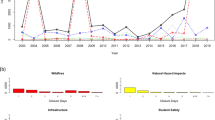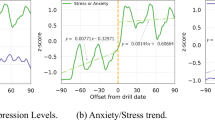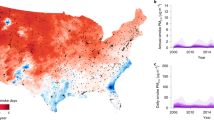Abstract
Wildfires have increased in frequency and severity over the past two decades, threatening to undo substantial air quality improvements. We investigate the relationship between wildfire smoke exposure and learning outcomes across the United States using standardized test scores from 2009–2016 for nearly 11,700 school districts and satellite-derived estimates of daily smoke exposure. Relative to a school year with no smoke, average cumulative smoke-attributable PM2.5 (surface particulate matter <2.5 μg m−3) exposure during the school year (~35 μg m−3) reduces test scores by ~0.15% of a standard deviation. These impacts are more pronounced among younger students and are observed across differing levels of economic disadvantage and racial/ethnic composition. Additionally, we project that smoke PM2.5 exposure in 2016 reduced discounted future earnings by nearly $1.7 billion ($111 per student). Roughly 80% of these costs are borne by disadvantaged districts. Our findings quantify a previously unaccounted for social cost of wildfire that is likely to worsen under a warming climate.
This is a preview of subscription content, access via your institution
Access options
Access Nature and 54 other Nature Portfolio journals
Get Nature+, our best-value online-access subscription
$29.99 / 30 days
cancel any time
Subscribe to this journal
Receive 12 digital issues and online access to articles
$119.00 per year
only $9.92 per issue
Buy this article
- Purchase on Springer Link
- Instant access to full article PDF
Prices may be subject to local taxes which are calculated during checkout




Similar content being viewed by others
Data availability
The weather data used in this study are available through the Parameter elevation Regressions on Independent Slopes Model (PRISM) Climate Group at Oregon State University (https://prism.oregonstate.edu). Student test performance and district-level covariate data are available through the Stanford Education Data Archive (SEDA) (https://purl.stanford.edu/db586ns4974). School location and student population data are available through the National Center for Education Statistics (NCES). Fire perimeter data used to calculate the distance of school districts to fire perimeters are available through the National Interagency Fire Center (NIFC) (https://data-nifc.opendata.arcgis.com/datasets/nifc::interagency-fire-perimeter-history-all-years). Smoke plume annotations are available through the National Environmental Satellite, Data and Information Service (NESDIS) Hazard Mapping System (HMS) (https://www.ospo.noaa.gov/Products/land/hms.html#data). Daily gridded estimates of PM2.5 concentrations are available from Di et al. (2021) (https://doi.org/10.7927/0rvr-4538; https://doi.org/10.1016/j.envint.2019.104909). Processed data to replicate the results in the main text and Supplementary Information are available at https://github.com/jeffwen/wildfire_smoke_education_public.
Code availability
The code to replicate the results and figures in the main text and supplementary material are available at https://github.com/jeffwen/wildfire_smoke_education_public.
References
Kitzberger, T., Falk, D. A., Westerling, A. L. & Swetnam, T. W. Direct and indirect climate controls predict heterogeneous early-mid 21st century wildfire burned area across western and boreal North America. PloS ONE 12, e0188486 (2017).
Dennison, P. E., Brewer, S. C., Arnold, J. D. & Moritz, M. A. Large wildfire trends in the western United States, 1984–2011. Geophys. Res. Lett. 41, 2928–2933 (2014).
Reid, C. E. et al. Critical review of health impacts of wildfire smoke exposure. Environ. Health Perspect. 124, 1334–1343 (2016).
Aguilera, R., Corringham, T., Gershunov, A. & Benmarhnia, T. Wildfire smoke impacts respiratory health more than fine particles from other sources: observational evidence from Southern California. Nat. Commun. 12, 1493 (2021).
Calderón-Garcidueñas, L. et al. Air pollution, cognitive deficits and brain abnormalities: a pilot study with children and dogs. Brain Cogn. 68, 117–127 (2008).
Block, M. L. & Calderón-Garcidueñas, L. Air pollution: mechanisms of neuroinflammation and CNS disease. Trends Neurosci. 32, 506–516 (2009).
Marcotte, D. E. Something in the air? Air quality and children’s educational outcomes. Econ. Educ. Rev. 56, 141–151 (2017).
Künn, S., Palacios Temprano, J. F. & Pestel, N. Indoor Air Quality and Cognitive Performance Discussion Paper No. 12632 (IZA, 2019).
Huang, J., Xu, N. & Yu, H. Pollution and performance: do investors make worse trades on hazy days? Manage. Sci. 66, 4455–4476 (2020).
Chang, T. Y., Graff Zivin, J., Gross, T. & Neidell, M. The effect of pollution on worker productivity: evidence from call center workers in China. Am. Econ. J. Appl. Econ. 11, 151–172 (2019).
Archsmith, J., Heyes, A. & Saberian, S. Air quality and error quantity: pollution and performance in a high-skilled, quality-focused occupation. J. Assoc. Environ. Resour. Econ. 5, 827–863 (2018).
La Nauze, A. & Severnini, E. Air Pollution and Adult Cognition: Evidence from Brain Training Working Paper 28785 (NBER, 2021).
Ebenstein, A., Lavy, V. & Roth, S. The long-run economic consequences of high-stakes examinations: evidence from transitory variation in pollution. Am. Econ. J. Appl. Econ. 8, 36–65 (2016).
Shier, V., Nicosia, N., Shih, R. & Datar, A. Ambient air pollution and children’s cognitive outcomes. Popul. Environ. 40, 347–367 (2019).
Zhang, X., Chen, X. & Zhang, X. The impact of exposure to air pollution on cognitive performance. Proc. Natl Acad. Sci. USA 115, 9193–9197 (2018).
Zivin, J. G., Liu, T., Song, Y., Tang, Q. & Zhang, P. The unintended impacts of agricultural fires: human capital in China. J. Dev. Econ. 147, 102560 (2020).
Lai, W., Li, S., Li, Y. & Tian, X. Air pollution and cognitive functions: evidence from straw burning in China. Am. J. Agric. Econ. 104, 190–208 (2022).
Laurent, J. G. C. et al. Associations between acute exposures to PM2.5 and carbon dioxide indoors and cognitive function in office workers: a multicountry longitudinal prospective observational study. Environ. Res. Lett. 16, 094047 (2021).
Shehab, M. & Pope, F. Effects of short-term exposure to particulate matter air pollution on cognitive performance. Sci. Rep. 9, 8237 (2019).
Carneiro, J., Cole, M. A. & Strobl, E. The effects of air pollution on students’ cognitive performance: evidence from Brazilian university entrance tests. J. Assoc. Environ. Resour. Econ. 8, 1051–1077 (2021).
Gao, X. et al. Short-term air pollution, cognitive performance and nonsteroidal anti-inflammatory drug use in the veterans affairs normative aging study. Nat. Aging 1, 430–437 (2021).
Calderón-Garcidueñas, L. et al. Long-term air pollution exposure is associated with neuroinflammation, an altered innate immune response, disruption of the blood-brain barrier, ultrafine particulate deposition, and accumulation of amyloid β-42 and α-synuclein in children and young adults. Toxicol. Pathol. 36, 289–310 (2008).
Fu, P., Guo, X., Cheung, F. M. H. & Yung, K. K. L. The association between PM2.5 exposure and neurological disorders: a systematic review and meta-analysis. Sci. Total Environ. 655, 1240–1248 (2019).
Lu, W., Hackman, D. A. & Schwartz, J. Ambient air pollution associated with lower academic achievement among US children: a nationwide panel study of school districts. Environ. Epidemiol. 5, e174 (2021).
Gilraine, M. Air Filters, Pollution and Student Achievement EdWorkingPapers (Annenberg Institute at Brown University, 2020); http://www.edworkingpapers.com/ai20-188
Liu, J. C. et al. Wildfire-specific fine particulate matter and risk of hospital admissions in urban and rural counties. Epidemiology 28, 77-85 (2017).
Burke, M. et al. The changing risk and burden of wildfire in the United States. Proc. Natl Acad. Sci. USA 118, e2011048118 (2021).
Marlon, J. R. et al. Long-term perspective on wildfires in the western USA. Proc. Natl Acad. Sci. USA 109, E535–E543 (2012).
Westerling, A. L., Hidalgo, H. G., Cayan, D. R. & Swetnam, T. W. Warming and earlier spring increase western U.S. forest wildfire activity. Science 313, 940–943 (2006).
Colmer, J., Hardman, I., Shimshack, J. & Voorheis, J. Disparities in PM2.5 air pollution in the United States. Science 369, 575–578 (2020).
Chan, W. R., Joh, J. & Sherman, M. H. Analysis of air leakage measurements of US houses. Energy Build. 66, 616–625 (2013).
Liang, Y. et al. Wildfire smoke impacts on indoor air quality assessed using crowdsourced data in California. Proc. Natl Acad. Sci. USA https://www.pnas.org/content/118/36/e2106478118 (2021). https://www.pnas.org/content/118/36/e2106478118.full.pdf
Park, R. J., Goodman, J., Hurwitz, M. & Smith, J. Heat and learning. Am. Econ. J. Econ. Policy 12, 306–339 (2020).
Park, R. J., Behrer, A. P. & Goodman, J. Learning is inhibited by heat exposure, both internationally and within the United States. Nat. Hum. Behav. 5, 19–27 (2021).
Tessum, C. W. et al. Inequity in consumption of goods and services adds to racial–ethnic disparities in air pollution exposure. Proc. Natl Acad. Sci. USA 116, 6001–6006 (2019).
Su, J. G., Jerrett, M., Morello-Frosch, R., Jesdale, B. M. & Kyle, A. D. Inequalities in cumulative environmental burdens among three urbanized counties in California. Environ. Int. 40, 79–87 (2012).
Lipfert, F. Air pollution and poverty: does the sword cut both ways? J. Epidemiol. Community Health 58, 2-3 (2004).
Legot, C., London, B. & Shandra, J. Environmental ascription: high-volume polluters, schools, and human capital. Organ. Environ. 23, 271–290 (2010).
Di, Q. et al. An ensemble-based model of PM2.5 concentration across the contiguous United States with high spatiotemporal resolution. Environ. Int. 130, 104909 (2019).
Di, Q. et al. Daily and Annual PM2.5 Concentrations for the Contiguous United States, 1-km Grids, v1 (2000–2016) (NASA, 2021); https://sedac.ciesin.columbia.edu/data/set/aqdh-pm2-5-concentrations-contiguous-us-1-km-2000-2016
PRISM Gridded Climate Data 2019 (Oregon State University PRISM Climate Group, accessed 2 March 2020); https://prism.oregonstate.edu
Bertrand, M., Duflo, E. & Mullainathan, S. How much should we trust differences-in-differences estimates? Q. J. Econ. 119, 249–275 (2004).
Abadie, A., Athey, S., Imbens, G. W. & Wooldridge, J. Clustering as a Design Problem Working paper (MIT Economics, 2016); http://economics.mit.edu/files/11355
Blattman, C., Green, D. P., Ortega, D. & Tobón, S. Place-based interventions at scale: the direct and spillover effects of policing and city services on crime. J. Eur. Econ. Assoc. 19, 2022–2051 (2021).
Mullen, C., Grineski, S. E., Collins, T. W. & Mendoza, D. L. Effects of PM2.5 on third grade students’ proficiency in math and english language arts. Int. J. Environ. Res. Public Health 17, 6931 (2020).
Brockmeyer, S. & d’Angiulli, A. How air pollution alters brain development: the role of neuroinflammation. Transl. Neurosci. 7, 24–30 (2016).
Burke, M. et al. Exposures and Behavioral Responses to Wildfire Smoke Working Paper 29380 (NBER, 2021).
Chetty, R., Friedman, J. N. & Rockoff, J. E. Measuring the impacts of teachers II: teacher value-added and student outcomes in adulthood. Am. Econ. Rev. 104, 2633–79 (2014).
Deryugina, T., Heutel, G., Miller, N. H., Molitor, D. & Reif, J. The mortality and medical costs of air pollution: evidence from changes in wind direction. Am. Econ. Rev. 109, 4178–4219 (2019).
Sunyer, J. et al. Traffic-related air pollution and attention in primary school children: short-term association. Epidemiology 28, 181–189 (2017).
Currie, J., Hanushek, E. A., Kahn, E. M., Neidell, M. & Rivkin, S. G. Does pollution increase school absences? Rev. Econ. Stat. 91, 682–694 (2009).
Holm, S. M., Miller, M. D. & Balmes, J. R. Health effects of wildfire smoke in children and public health tools: a narrative review. J. Expo. Sci. Environ. Epidemiol. 31, 1–20 (2021).
Mohai, P., Kweon, B.-S., Lee, S. & Ard, K. Air pollution around schools is linked to poorer student health and academic performance. Health Aff. 30, 852–862 (2011).
Klein, M., Sosu, E. M. & Dare, S. School absenteeism and academic achievement: does the reason for absence matter? AERA Open 8, 23328584211071115 (2022).
Heft-Neal, S., Driscoll, A., Yang, W., Shaw, G. & Burke, M. Associations between wildfire smoke exposure during pregnancy and risk of preterm birth in California. Environ. Res. 203, 111872 (2022).
Burnett, R. et al. Global estimates of mortality associated with long-term exposure to outdoor fine particulate matter. Proc. Natl Acad. Sci. USA 115, 9592–9597 (2018).
Brey, S. J., Ruminski, M., Atwood, S. A. & Fischer, E. V. Connecting smoke plumes to sources using hazard mapping system (hms) smoke and fire location data over North America. Atmos. Chem. Phys. 18, 1745–1761 (2018).
Reardon, S. F. et al. Stanford Education Data Archive (version 4.0) (Stanford Libraries, 2021); http://purl.stanford.edu/db586ns4974
Fahle, E. M. et al. Stanford Education Data Archive Technical Documentation Version 4.0 (Stanford Libraries, 2021).
Reardon, S. F. Educational opportunity in early and middle childhood: using full population administrative data to study variation by place and age. RSF 5, 40–68 (2019).
Bergé, L. Efficient Estimation of Maximum Likelihood Models with Multiple Fixed-effects: the R Package FENmlm Discussion Papers (CREA, University of Luxembourg, 2018).
Wildland Fire Management Research, Development, & Application program data team. Interagency Fire Perimeter History - All Years (National Interagency Fire Center, accessed 30 January 2021); https://data-nifc.opendata.arcgis.com/datasets/nifc::interagency-fire-perimeter-history-all-years/about
Wong, S. D., Broader, J. C. & Shaheen, S. A. Review of California Wildfire Evacuations from 2017 to 2019 (UC Berkeley Institute of Transportation Studies, 2020).
Radeloff, V. C. et al. The wildland–urban interface in the United States. Ecol. Appl. 15, 799–805 (2005).
Acknowledgements
We thank the ECHOLab at Stanford University and the Exploring the ‘Hidden Burden’ of Climate Change and Pollution on Mental Health and Conflict session at American Geophysical Union 2020 for helpful discussions and comments. M.B. thanks the Robert Wood Johnson Foundation (ID No. 76555) for funding. J.W. gratefully acknowledges partial funding from Stanford Data Science for this work. The funders had no role in study design, data collection and analysis, decision to publish or preparation of the manuscript.
Author information
Authors and Affiliations
Contributions
J.W. and M.B. contributed to the conception and design of the study. J.W. conducted data extraction and econometric analysis. J.W. and M.B. analysed the results and wrote the paper.
Corresponding author
Ethics declarations
Competing interests
The authors declare no competing interests.
Peer review
Peer review information
Nature Sustainability thanks Tarik Benmarhnia, Caroline Gao, Fay Johnston and the other, anonymous, reviewer(s) for their contribution to the peer review of this work.
Additional information
Publisher’s note Springer Nature remains neutral with regard to jurisdictional claims in published maps and institutional affiliations.
Supplementary information
Supplementary Information
Supplementary Note, Figs. 1–6 and Tables 1–4.
Rights and permissions
Springer Nature or its licensor holds exclusive rights to this article under a publishing agreement with the author(s) or other rightsholder(s); author self-archiving of the accepted manuscript version of this article is solely governed by the terms of such publishing agreement and applicable law.
About this article
Cite this article
Wen, J., Burke, M. Lower test scores from wildfire smoke exposure. Nat Sustain 5, 947–955 (2022). https://doi.org/10.1038/s41893-022-00956-y
Received:
Accepted:
Published:
Issue Date:
DOI: https://doi.org/10.1038/s41893-022-00956-y
This article is cited by
-
Education outcomes in the era of global climate change
Nature Climate Change (2024)
-
Boil water alerts and their impact on the unexcused absence rate in public schools in Jackson, Mississippi
Nature Water (2023)
-
Summers up in smoke
Nature Sustainability (2023)
-
Environmental Influences on Academic Proficiency
Current Epidemiology Reports (2023)



